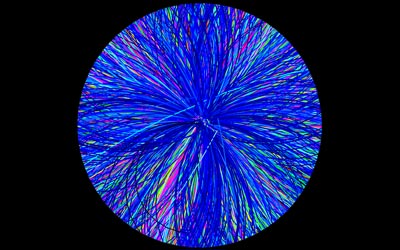
In the early hours of Sunday morning, the first collisions between lead ions were recorded at the Large Hadron Collider (LHC) at CERN. The complete transition from protons to lead took just four days, after the final proton beams of 2010 were extracted from the LHC last Thursday.
“The speed of the transition to lead ions is a sign of the maturity of the LHC,” says Rolf-Dieter Heuer, CERN’s director-general. “The machine is running like clockwork after just a few months of routine operation.”
The development marks the beginning of the main physics programme for the ALICE experiment, which has been designed specifically for heavy-ion collisions and is seeking to recreate the conditions that existed just 10–11 s after the Big Bang. At this time, the energy in the universe was so concentrated that protons and neutrons could not hold together – instead, space began to be filled with a dense soup of subatomic particles known as quark–gluon plasma.
Strong but mysterious
One of ALICE’s main scientific goals is to characterize the quark–qluon plasma in an attempt to find out more about the nature of the strong force, one of the four fundamental forces in nature. Despite being responsible for generating 98% of the mass of atoms, the strong force is still the most poorly understood of the forces.
To do this, the detector was specifically designed to track large numbers of particles. It can detect up to 15,000 particles per event, which may be produced from the collisions between lead nuclei occurring in the centre of the detector.
These images show the first collisions, recorded yesterday by ALICE’s innermost detector, the Inner Tracking System. The shaded structures represent a perspective view of the detector elements; and the lines are the reconstructed particle trajectories with the colour scale indicating the energy of the particles. As expected such collisions produce an unprecedented number of particles, reaching 2500–3000 charged particles per collision.
Mini Big Bangs
“We are thrilled with the achievement!” says David Evans, leader of the UK team at the ALICE experiment. “The collisions generated mini Big Bangs and the highest temperatures and densities ever achieved in an experiment.”
Lead ions within the LHC are colliding with a centre-of-mass energy of 2.76 TeV per colliding nucleon pair, which generates temperatures in the region of 10 trillion degrees. The temperatures and densities are an order of magnitude larger than the previous record held by the Relativistic Heavy Ion Collider (RHIC) at the Brookhaven National Laboratory in the US.
CERN engineers will now spend up to a week tuning the beamlines in preparation for the scientific programme. Evans and his fellow researchers will then record data until 6 December when CERN will shut down for maintenance work over Christmas. Operation of the collider will start again with protons in February and physics runs will continue through 2011.













